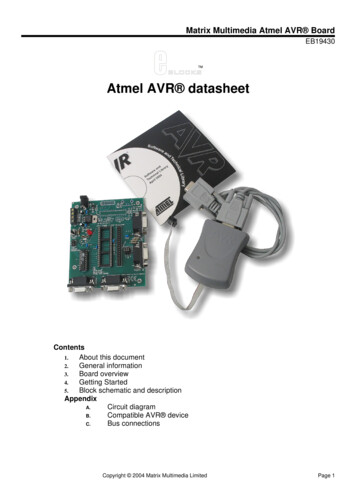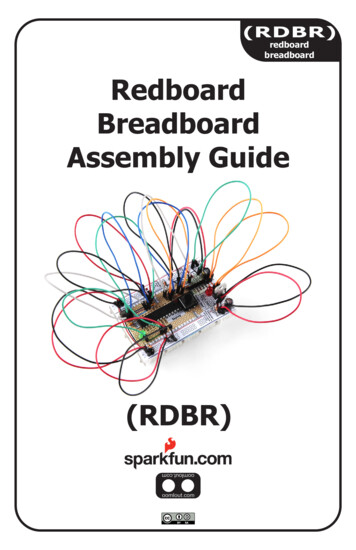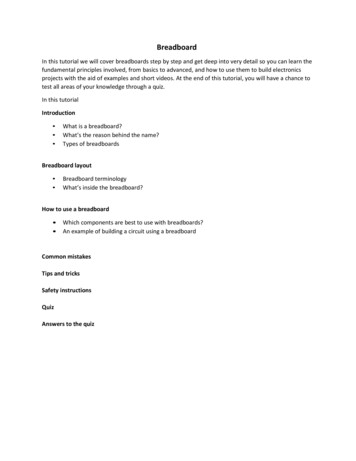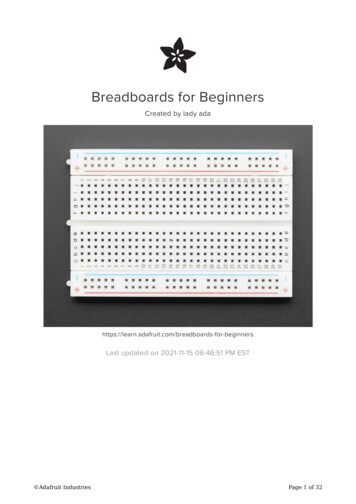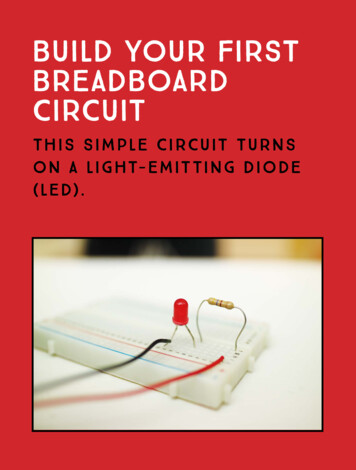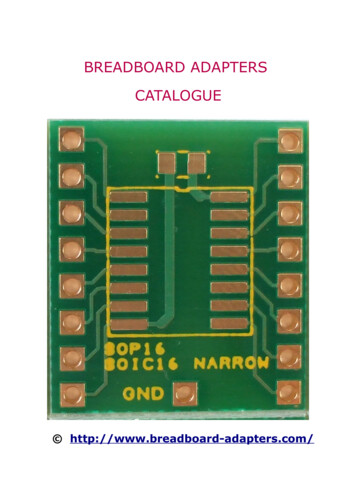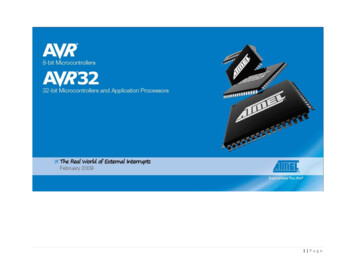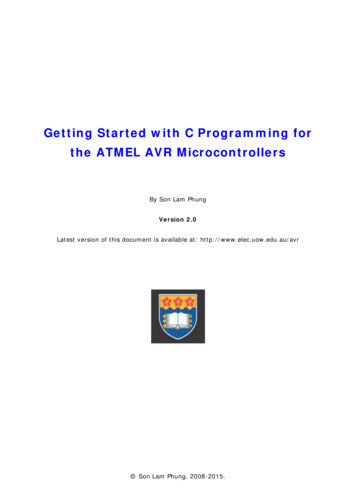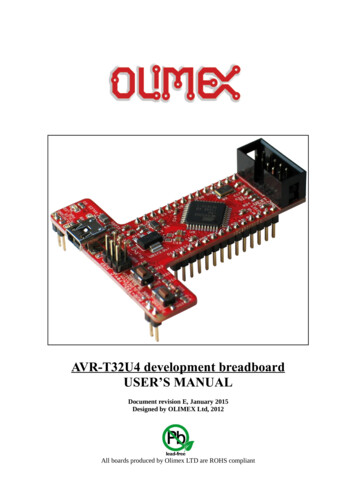
Transcription
AVR-T32U4 development breadboardUSER’S MANUALDocument revision E, January 2015Designed by OLIMEX Ltd, 2012All boards produced by Olimex LTD are ROHS compliant
OLIMEX 2015AVR-T32U4 user's manual 2015 Olimex Ltd. Olimex , logo and combinations thereof, are registered trademarks of Olimex Ltd. Other productnames may be trademarks of others and the rights belong to their respective owners.The information in this document is provided in connection with Olimex products. No license, express or impliedor otherwise, to any intellectual property right is granted by this document or in connection with the sale ofOlimex products.This work is licensed under the Creative Commons Attribution-ShareAlike 3.0 Unported License. To view a copy ofthis license, visit .This hardware design by Olimex LTD is licensed under a Creative Commons Attribution-ShareAlike 3.0 UnportedLicense.The software is released under GPL.It is possible that the pictures in this manual differ from the latest revision of the board.The product described in this document is subject to continuous development and improvements. All particulars of theproduct and its use contained in this document are given by OLIMEX in good faith. However all warranties implied orexpressed including but not limited to implied warranties of merchantability or fitness for purpose are excluded. Thisdocument is intended only to assist the reader in the use of the product. OLIMEX Ltd. shall not be liable for any loss ordamage arising from the use of any information in this document or any error or omission in such information or anyincorrect use of the product.This evaluation board/kit is intended for use for engineering development, demonstration, or evaluation purposes onlyand is not considered by OLIMEX to be a finished end-product fit for general consumer use. Persons handling theproduct must have electronics training and observe good engineering practice standards. As such, the goods beingprovided are not intended to be complete in terms of required design-, marketing-, and/or manufacturing-relatedprotective considerations, including product safety and environmental measures typically found in end products thatincorporate such semiconductor components or circuit boards.Olimex currently deals with a variety of customers for products, and therefore our arrangement with the user is notexclusive. Olimex assumes no liability for applications assistance, customer product design, software performance, orinfringement of patents or services described herein.THERE IS NO WARRANTY FOR THE DESIGN MATERIALS AND THE COMPONENTSUSED TO CREATE AVR-T32U4. THEY ARE CONSIDERED SUITABLE ONLY FOR AVRT32U4Page 2 of 29
OLIMEX 2015AVR-T32U4 user's manualTable of ContentsCHAPTER 1 OVERVIEW. 51. Introduction to the chapter. 51.1 Features.51.2 Similar boards. 51.3 Organization.5Chapter 2 Introduction to arduino/pinguino/maple.72. What is Arduino?. 72.1 First steps with Arduino IDE.82.1.1 For purchases after the official release of Leonardo.82.1.2 For purchases before the official release of Leonardo.8CHAPTER 3 SETTING UP THE AVR-T32U4 BOARD.103. Introduction to the chapter. 103.1 Electrostatic warning.103.2 Requirements.103.3 Powering the board. 113.4 Prebuilt software. 12CHAPTER 4 AVR-T32U4 BOARD DESCRIPTION.134. Introduction to the chapter. 134.1 Layout (top view). 134.2 Layout (bottom view).14CHAPTER 5 THE ATMEGA32U4 MICROCONTROLLER.155. Introduction to the chapter. 155.1 The micro-controller’s features.15CHAPTER 6 CONTROL CIRCUITY. 176. Introduction to the chapter. 176.1 Reset. 176.2 Clock.17CHAPTER 7 HARDWARE.187. Introduction to the chapter. 187.1 ICSP pin holes.187.2 UEXT.187.3 Extension pins.197.4 USB mini connector. 207.5 Jumper description. 207.6 Additional hardware components.21CHAPTER 8 MEMORY AND BLOCK DIAGRAM.228. Introduction to the chapter. 22Page 3 of 29
OLIMEX 2015AVR-T32U4 user's manual8.1 Memory organization. 23CHAPTER 9 SCHEMATICS.249. Introduction to the chapter. 249.1 Eagle schematic. 249.2 Physical dimensions. 26CHAPTER 10 REVISION HISTORY.2710. Introduction to the chapter. 2710.1 Document revision.2710.2 Web page of your device.2810.3 Product support.29Page 4 of 29
OLIMEX 2015AVR-T32U4 user's manualCHAPTER 1 OVERVIEW1. Introduction to the chapterThank you for choosing the AVR-T32U4 development board from Olimex! This document providesa User’s Guide for the Olimex AVR-T32U4 development board. As an overview, this chapter givesthe scope of this document and lists the board’s features. The document’s organization is thendetailed.The AVR-T32U4 development board enables code development of applications running on theATMega32U4 microcontroller, manufactured by Microchip technology.1.1 FeaturesSome of the features of the board are listed below: ATMEGA32U4 microcontroller, all in one USB communication no need for external FTDI chip.Input power supply taken from mini USBFeeds power to the breadboard busWorks both on 3.3V and 5VUEXT connector which allow many existing modules like RF, ZIGBEE, GSM, GPS to beconnectedThe LEDs and the BUTTONs are on the edge of the board so there is easy access even if theboards have shields on themMini USB connector is used which is common and used in most cell phones, so you do nothave to buy other cables1.2 Similar boardsAVR-T32U4 is ARDUINO-LEONARDO-like breadboard with ATMega32U4.It is a powerful board considering its low price but yet a starter board for the Arduino family.The more powerful Arduino boards we have in the range are OLIMEXINO-32U4 again based onLeonardo and OLIMEXINO-328 – based on Arduino Duenomilanove. Both differ from AVRT32U4 in having the standard Arduino shield connectors and additional features. OLIMEXINO-328has a more sophisticated supply circuit, USB OTG connector and there are more Arduino projectsavailable for it.1.3 OrganizationEach section in this document covers a separate topic, organized as follow:– Chapter 1 is an overview of the board usage and features– Chapter 2 has a short introduction to Arduino platform and its derivatives Pinguino andPage 5 of 29
OLIMEX 2015––––––––AVR-T32U4 user's manualMapleChapter 3 provides a guide for quickly setting up the boardChapter 4 contains the general board diagram and layoutChapter 5 describes the component that is the heart of the board: the ATMega32U4microcontrollerChapter 6 is an explanation of the control circuitry associated with the microcontroller toreset. Also shows the clocks on the boardChapter 7 covers the connector pinout, peripherals and jumper descriptionChapter 8 shows the processor diagram and memory mapChapter 9 provides the schematicsChapter 10 contains the revision historyPage 6 of 29
OLIMEX 2015AVR-T32U4 user's manualCHAPTER 2 INTRODUCTION TO ARDUINO/PINGUINO/MAPLE2. What is Arduino?Arduino is an open-source electronics prototyping platform, designed to make the process of usingelectronics in multidisciplinary projects easily accessible. The hardware consists of a simple openhardware design for the Arduino board with an Atmel AVR processor and on-board I/O support. Thesoftware consists of a standard programming language and the boot loader that runs on the board.Arduino hardware is programmed using a Wiring-based language (syntax libraries), similar to C with some simplifications and modifications, and a Processing-based Integrated DevelopmentEnvironment (IDE).The project began in Ivrea, Italy in 2005 aiming to make a device for controlling student-builtinteraction design projects less expensively than other prototyping systems available at the time. Asof February 2010 more than 120,000 Arduino boards had been shipped. Founders Massimo Banziand David Cuartielles named the project after a local bar named Arduino. The name is an Italianmasculine first name, meaning "strong friend". The English pronunciation is "Hardwin", anamesake of Arduino of Ivrea.More information could be found at the creators web page http://arduino.cc/ and in the ArduinoWiki http://en.wikipedia.org/wiki/ArduinoTo make the story short – Arduino is easy for beginners who lack Electronics knowledge, but alsodoes not restrict professionals as they can program it in C or mix of Arduino/C language.There are thousands of projects which makes it easy to startup as there is barely no field whereArduino enthusiasts to have not been already.Arduino has inspired two other major derivates - MAPLE and PINGUINO. Based on 8-bit AVRtechnology the computational power of Arduino boards is modest, this is why a team from MITdeveloped the MAPLE project which is based on ARM7 STM32F103RBT6 microcontroller. Theboard has same friendly IDE as Arduino and offers the same capabilities as hardware and softwarebut runs the Arduino code much faster. The Maple project can be found at http://leaflabs.comIn parallel with Arduino another project was started called PINGUINO. This project chose its firstimplementation to be with PIC microcontrollers, as AVRs were hard to find in some parts of theworld like South America so it is likely to see lot of PINGUINO developers are from that part of theworld. PINGUINO project founders decided to go with Python instead Java for processinglanguage. For the moment PINGUINO is much more flexible than Arduino as it is not limited to8bit microcontrollers. Currently the IDE, which has GCC in background, can support 8-bit PICmicrocontrollers, 32bit PIC32 (MIPS) microcontrollers and ARM7/CORTEXM3 microcontrollerswhich makes PINGUINO very flexible because once you make your project you can migrate easilythrough different hardware platforms and not being bound to a single microcontroller manufacturer.The PINGUINO project can be found at: http://www.pinguino.cc.Page 7 of 29
OLIMEX 2015AVR-T32U4 user's manual2.1 First steps with Arduino IDEDepending when you purchased the board there are two scenarios since the PID (product ID) whichis stored in the firmware and expected by the IDE is different between versions 1.0.0 and 1.0.1(1.0.1 is the first release of the Arduino IDE with official support for Leonardo).2.1.1 For purchases after the official release of LeonardoBoards produced after the official release of Arduino Leonardo have the latest bootloader availablewith the adjusted bootloader PID. Download the latest Arduino IDE and extract the package. Youcan find the needed driver for the bootloader located in folder /drivers. You click update on thedevice in device manager and point the installer to the /drivers folder.Then launch Arduino IDE and set the correct board and COM port in TOOLS menu.From File- Open navigate to the examples folder which is found in the Arduino IDE installationfolder. Choose a simple example to begin with like BlinkWithoutDelay.ino and open it. Click verifyand after it compiles click “Upload”. Voila, you have uploaded code to your Arduino device.Now start exploring the world of Arduino! More info and help on the software can be found and theofficial Arduino web site: http://www.arduino.cc/.2.1.2 For purchases before the official release of LeonardoIf you have purchased the T-32U4 before the official release of the Arduino Leonardo board thereare two scenarios for using Arduino IDE:1) Download Arduino IDE 1.0 RC2 or Arduino IDE 1.0.0. When you extract the package check ifthe Arduino Leonardo section is the \hardware\arduino\boards is uncommented. If the section hasnumber signs (#) infront remove the number signs (#).2) If you want to use the latest version (which by the time of writing is 1.0.1) you would need tochange to bootloader firmware. This will require an AVR programmer tool.You can get the bootloader in .elf format from our web site. You can also use the original bootloaderhex if you set the fuses and lock bits for the processor as follows:low fuses 0xffhigh fuses 0xd8extended fuses 0xcblock bits (choose “SPM Prohibited in Boot Section”) from the drop down menu which will set thebits either to EF or 2F.Page 8 of 29
OLIMEX 2015AVR-T32U4 user's manualAfter you have downloaded and extracted the desired IDE you need to install the driver for youroperating system. You can find the needed driver for the bootloader located in folder /drivers. Youclick update on the device in device manager and point the installer to the /drivers folder.Then launch Arduino IDE and set the correct board and COM port in TOOLS menu.From File- Open navigate to the examples folder which is found in the Arduino IDE installationfolder. Choose a simple example to begin with like BlinkWithoutDelay.ino and open it. Click verifyand after it compiles click “Upload”. Voila, you have uploaded code to your Arduino device.Now start exploring the world of Arduino! More info and help on the software can be found and theofficial Arduino web site: http://www.arduino.cc/.Page 9 of 29
OLIMEX 2015AVR-T32U4 user's manualCHAPTER 3 SETTING UP THE AVR-T32U4 BOARD3. Introduction to the chapterThis section helps you set up the AVR-T32U4 development board for the first time.Please consider first the electrostatic warning to avoid damaging the board, then discover thehardware and software required to operate the board.The procedure to power up the board is given, and a description of the default board behavior isdetailed.3.1 Electrostatic warningAVR-T32U4 is shipped in a protective anti-static package. The board must not be exposed to highelectrostatic potentials. A grounding strap or similar protective device should be worn whenhandling the board. Avoid touching the component pins or any other metallic element.3.2 RequirementsIn order to set up the AVR-T32U4, the following items are required:If using the free ARDUINO IDE the ONLY requirement is a miniUSB to USB-A cable to connectto a computer.Since this is a board mainly focused on breadboarding having a breadboard is highly advisable. Thisway you can have access to the free pins using jumper wires and no need of pesky soldering andunsoldering! Good and cheap choices are the ones we offer:BREADBOARD-1 – 82 52 10 mm solderless breadboard for experimentingBREADBOARD–MINI – 45 35 8.5 mm solderless breadboard for experimentingOn the next page you can find a picutre of AVR-T32U4 mounted on a breadboard.Page 10 of 29
OLIMEX 2015AVR-T32U4 user's manualIf you want to upgrade the bootloader, or program the board without the ARDUINO-IDE there arepinouts for ICSP programmer (note that there IS a 6-pin connector mounted). You can use our AVRISP-ISO, or AVR-ISP-TINY programmer for custom programming without ARDUINO IDE.Having an AVR programmer is highly advisable since the bootloader software is still not perfectand it is possible to destroy it only by software means (for instance disabling all interrupts and thenentering infinite loop would hang the bootloader) which would require reinstalling the bootloader.3.3 Powering the boardThe AVR-T32U4 board is self-powered by the miniUSB if it is connected to a USB hub of acomputer.Alternatively it can be powered via the power pins located at the bottom of the board. You mayprovide between 3.0V and 5V on one of those proto power pins to power the board. Additionally, ifthe board is powered by USB you might find 3.3V out on those same pins. Please check the pictureabove – the lines that might be used for powering connect at the breadboard at the “ ” and “-” lines.IMPORTANT – DO NOT POWER AVR-T32U4 FROM BOTH THE USB AND THE PROTOPOWER PINS SIMULTANEOUSLY. THIS WOULD LEAD TO SHORT CIRCUIT OROVERVOLTAGE!The bootloader starts automatically.On powering the board PWR LED should turn on. RXLED and TXLED should turn on andPage 11 of 29
OLIMEX 2015AVR-T32U4 user's manualmonitor the send receive on the virtual COM port.3.4 Prebuilt softwareThe board comes with prebuilt ARDUINO bootloader. The different part between the otherArduinos and Leonardo is that Leonardo doesn't use FTDI chip nor external chip for the virtualCOM port but it is handled by the ATMega32U4.Page 12 of 29
OLIMEX 2015AVR-T32U4 user's manualCHAPTER 4 AVR-T32U4 BOARD DESCRIPTION4. Introduction to the chapterHere you get acquainted with the main parts of the board. Note the names used on the board differfrom the names used to describe them. For the actual names check the AVR-T32U4 board itself.4.1 Layout (top view)Page 13 of 29
OLIMEX 2015AVR-T32U4 user's manual4.2 Layout (bottom view)Page 14 of 29
OLIMEX 2015AVR-T32U4 user's manualCHAPTER 5 THE ATMEGA32U4 MICROCONTROLLER5. Introduction to the chapterIn this chapter is located the information about the heart of AVR-T32U4 – its microcontroller. Theinformation is a modified version of the datasheet provided by its manufacturers.5.1 The micro-controller’s featuresAs per Atmel's datashet: High Performance, Low Power AVR 8-Bit Microcontroller Advanced RISC Architecture– 135 Powerful Instructions – Most Single Clock Cycle Execution– 32 8 General Purpose Working Registers– Fully Static Operation– Up to 16 MIPS Throughput at 16 MHz– On-Chip 2-cycle Multiplier Non-volatile Program and Data Memories– 32K Bytes of In-System Self-Programmable Flash– 2.5K Bytes Internal SRAM– 1K Bytes Internal EEPROM– Write/Erase Cycles: 10,000 Flash/100,000 EEPROM– Data retention: 20 years at 85 C/ 100 years at 25 C(1)– Optional Boot Code Section with Independent Lock BitsIn-System Programming by On-chip Boot ProgramTrue Read-While-Write OperationAll supplied parts are preprogramed with a default USB bootloader– Programming Lock for Software Security JTAG (IEEE std. 1149.1 compliant) Interface– Boundary-scan Capabilities According to the JTAG Standard– Extensive On-chip Debug Support– Programming of Flash, EEPROM, Fuses, and Lock Bits through the JTAGInterface USB 2.0 Full-speed/Low Speed Device Module with Interrupt on Transfer Completion– Complies fully with Universal Serial Bus Specification Rev 2.0– Supports data transfer rates up to 12 Mbit/s and 1.5 Mbit/s– Endpoint 0 for Control Transfers: up to 64-bytes– 6 Programmable Endpoints with IN or Out Directions and with Bulk, Interrupt orIsochronous Transfers– Configurable Endpoints size up to 256 bytes in double bank mode– Fully independent 832 bytes USB DPRAM for endpoint memory allocation– Suspend/Resume Interrupts– CPU Reset possible on USB Bus Reset detection– 48 MHz from PLL for Full-speed Bus Operation– USB Bus Connection/Disconnection on Microcontroller Request– Crystal-less operation for Low Speed modePage 15 of 29
OLIMEX 2015AVR-T32U4 user's manual Peripheral Features– On-chip PLL for USB and High Speed Timer: 32 up to 96 MHz operation– One 8-bit Timer/Counter with Separate Prescaler and Compare Mode– Two 16-bit Timer/Counter with Separate Prescaler, Compare- and Capture Mode– One 10-bit High-Speed Timer/Counter with PLL (64 MHz) and Compare Mode– Four 8-bit PWM Channels– Four PWM Channels with Programmable Resolution from 2 to 16 Bits– Six PWM Channels for High Speed Operation, with Programmable Resolution from2 to 11 Bits– Output Compare Modulator– 12-channels, 10-bit ADC (features Differential Channels with Programmable Gain)– Programmable Serial USART with Hardware Flow Control– Master/Slave SPI Serial Interface– Byte Oriented 2-wire Serial Interface– Programmable Watchdog Timer with Separate On-chip Oscillator– On-chip Analog Comparator– Interrupt and Wake-up on Pin Change– On-chip Temperature Sensor Special Microcontroller Features– Power-on Reset and Programmable Brown-out Detection– Internal 8 MHz Calibrated Oscillator– Internal clock prescaler & On-the-fly Clock Switching (Int RC / Ext Osc)– External and Internal Interrupt Sources– Six Sleep Modes: Idle, ADC Noise Reduction, Power-save, Power-down, Standby, andExtended Standby I/O and Package– All I/O combine CMOS outputs and LVTTL inputs– 26 Programmable I/O Lines– 44-lead QFN Package, 7 7mm Operating Voltages– 2.7 – 5.5V Operating temperature– Industrial (-40 C to 85 C) Maximum Frequency– 8 MHz at 2.7V – Industrial range– 16 MHz at 4.5V – Industrial rangeFor comprehensive information on the microcontroller visit the Atmel web page for a datasheet.At the moment of writing the microcontroller datasheet can be found at the following link:http://www.atmel.com/Images/doc7766.pdfPage 16 of 29
OLIMEX 2015AVR-T32U4 user's manualCHAPTER 6 CONTROL CIRCUITY6. Introduction to the chapterHere you can find information about reset circuit, power circuit and quartz crystal locations.6.1 ResetAVR-T32U4 reset circuit includes R12 (4.7kΩ), R13 (330Ω), SD5 (Shottky diode), ATMega32U4pin 13 (#RESET) and a RESET button. Note that it also can be found at the ICSP header pin 5 andtest pad RESET.6.2 Clock16 MHz quartz crystal Q1 is found at pins 16 and 17 of the processor.Note that by default the board is powered by 3.3V. At 3.3V the maximum frequency that can beachieved with ATmega32u4 is around 10MHz. Since it is relatively easy to set the board to 5Voperation we decided to go with the 16Mhz quartz (instead of 8MHz one), thus overclocking theboard. The main ATmega32u4 can operate at the maximum clock speed available (16 MHz) only ifpowered by at least 4.5V.IMPORTANT: If the board has a quartz crystal rotated at 45 degrees relative to the pads provideddo not panic. This is normal. We have two types of such crystals – one of them requires 4 pads, theother only 2 pads. That is why we have provided 4 pads to be able to fit both crystals. All boardsOlimex manufactures pass automatized optical inspection after assembly and obvious misplacementlike this is impossible to occur.Page 17 of 29
OLIMEX 2015AVR-T32U4 user's manualCHAPTER 7 HARDWARE7. Introduction to the chapterIn this chapter are presented the connectors that can be found on the board all together with theirpinout. Proto area is shown. Jumpers functions are described. Notes and info on specific peripheralsare presented. Notes regarding the interfaces are given.7.1 ICSP pin holesThe 6 pin ICSP header provides interface for custom programming/debugging outside of thePINGUINO IDE. Note the pin holes have a connector mounted over. The pinout can be found in thetable below. It is important to check the jumper configuration for proper use of the ICSP pin hole .ICSP pin holesPin #Signal namePin #Signal name1MISO (PB3)4MOSI (PB2)2Vcc5RESET3SCK (PB1)6GND7.2 UEXTAVR-T32U4 board has UEXT connector and can interface Olimex's UEXT modules.For more information on our UEXT modules please visit:http://www.olimex.com/OTHER/UEXT.pdfPin # Signal name1 3.3V2GND3TXD4RXD5SCL6SDA7MISO8MOSI9SCK10UEXT #CSPage 18 of 29
OLIMEX 2015AVR-T32U4 user's manual7.3 Extension pinsFor your convenience the pads are named individually near each of them. Please take extra careabout the numbering but consider that there might be offset.Also note that the board comes with no connectors soldered on the pin holes. Before being able toconnect with a shield you have to solder connecters yourself.Pad nameSignalPad nameSignalAREFAREFD13(UEXT #HWB 1A2PF5/ADC5/TMSD7 (BOOT DC8D17(MISO)PB3/PDO/PCINT3/MISOD3 D2 (SDA)PD1/SDA/INT1D15(SCK)PB1/PCINT1/SCLKD1 (TXD)PD3/TXD1/INT3PB0/SS/PCINT0D0 (RXD)PD2/RXD1/INT2D14Page 19 of 29INT6/AIN0/PE6
OLIMEX 2015AVR-T32U4 user's manual7.4 USB mini connectorNote that the USB is confiugred only as device.Pin #Signal name1 5V2D-3D 4Not connected5GND7.5 Jumper descriptionAll jumpers on AVR-T32U4 are board mounted SMT type. This means you would need to cut orsolder to be able to change the position. You would need basic soldering tools and skills to be ableto change the positions.7.5.1 Jumper 5V EIf you close 5V E then the 3.3V voltage regulator VR1 would be bypassed. 5V from the USB or theproto powering pins would go directly to the board. It would be a good idea to remove VR1completely if you decide to close 5V E.Default state is open.7.5.2 Jumper R23 EControls the SPI SCL 4.7k pull-up resistor. By default the jumper is closed and the resistor isenabled.Default position is closed.7.5.3 Jumper R24 EControls the SPI SDA 4.7k pull-up resistor. By default the jumper is closed and the resistor isenabled.Default position is closed.7.5.4 Jumper R25 EControls the SPI CS (chip select) 4.7k pull-up resistor. By default the jumper is closed and theresistor is enabled.Default state is closed.Page 20 of 29
OLIMEX 2015AVR-T32U4 user's manual7.6 Additional hardware componentsThe components below are mounted on the AVR-T32U4 board but are not discussed above. Theyare listed here for completeness:General purpose button2 LEDs showing virtual port activityPage 21 of 29
OLIMEX 2015AVR-T32U4 user's manualCHAPTER 8 MEMORY AND BLOCK DIAGRAM8. Introduction to the chapterA block diagram of the processor is located below. On the next page you can find a memory mapfor this family of processors. It is strongly recommended to refer to the original datasheet releasedby Atmel for ones of higher quality.Page 22 of 29
OLIMEX 2015AVR-T32U4 user's manual8.1 Memory organizationPage 23 of 29
OLIMEX 2015AVR-T32U4 user's manualCHAPTER 9 SCHEMATICS9. Introduction to the chapterIn this chapter are located the schematics describing logically and physically AVR-T32U4.9.1 Eagle schematicAVR-T32U4 schematic is visible for reference here. You may zoom the pdf for a better view. Searchis also available. You can also find the sche
It is a powerful board considering its low price but yet a starter board for the Arduino family. The more powerful Arduino boards we have in the range are OLIMEXINO-32U4 again based on Leonardo and OLIMEXINO-328 - based on Arduino Duenomilanove. Both differ from AVR-T32U4 in having the standard Arduino shield connectors and additional features.
